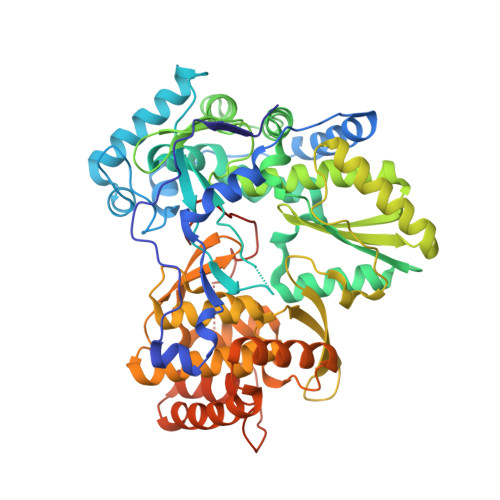Inhibition of RNA binding to hepatitis C virus RNA-dependent RNA polymerase: a new mechanism for antiviral intervention.
Ahmed-Belkacem, A., Guichou, J.F., Brillet, R., Ahnou, N., Hernandez, E., Pallier, C., Pawlotsky, J.M.(2014) Nucleic Acids Res 42: 9399-9409
- PubMed: 25053847
- DOI: https://doi.org/10.1093/nar/gku632
- Primary Citation of Related Structures:
4OOW - PubMed Abstract:
The hepatitis C virus (HCV) RNA-dependent RNA polymerase (RdRp) is a key target for antiviral intervention. The goal of this study was to identify the binding site and unravel the molecular mechanism by which natural flavonoids efficiently inhibit HCV RdRp. Screening identified the flavonol quercetagetin as the most potent inhibitor of HCV RdRp activity. Quercetagetin was found to inhibit RdRp through inhibition of RNA binding to the viral polymerase, a yet unknown antiviral mechanism. X-ray crystallographic structure analysis of the RdRp-quercetagetin complex identified quercetagetin's binding site at the entrance of the RNA template tunnel, confirming its original mode of action. This antiviral mechanism was associated with a high barrier to resistance in both site-directed mutagenesis and long-term selection experiments. In conclusion, we identified a new mechanism for non-nucleoside inhibition of HCV RdRp through inhibition of RNA binding to the enzyme, a mechanism associated with broad genotypic activity and a high barrier to resistance. Our results open the way to new antiviral approaches for HCV and other viruses that use an RdRp based on RNA binding inhibition, that could prove to be useful in human, animal or plant viral infections.
- Inserm U955, Hôpital Henri Mondor, 51 avenue du Maréchal de Lattre de Tassigny, 94010 Créteil, France.
Organizational Affiliation:

















